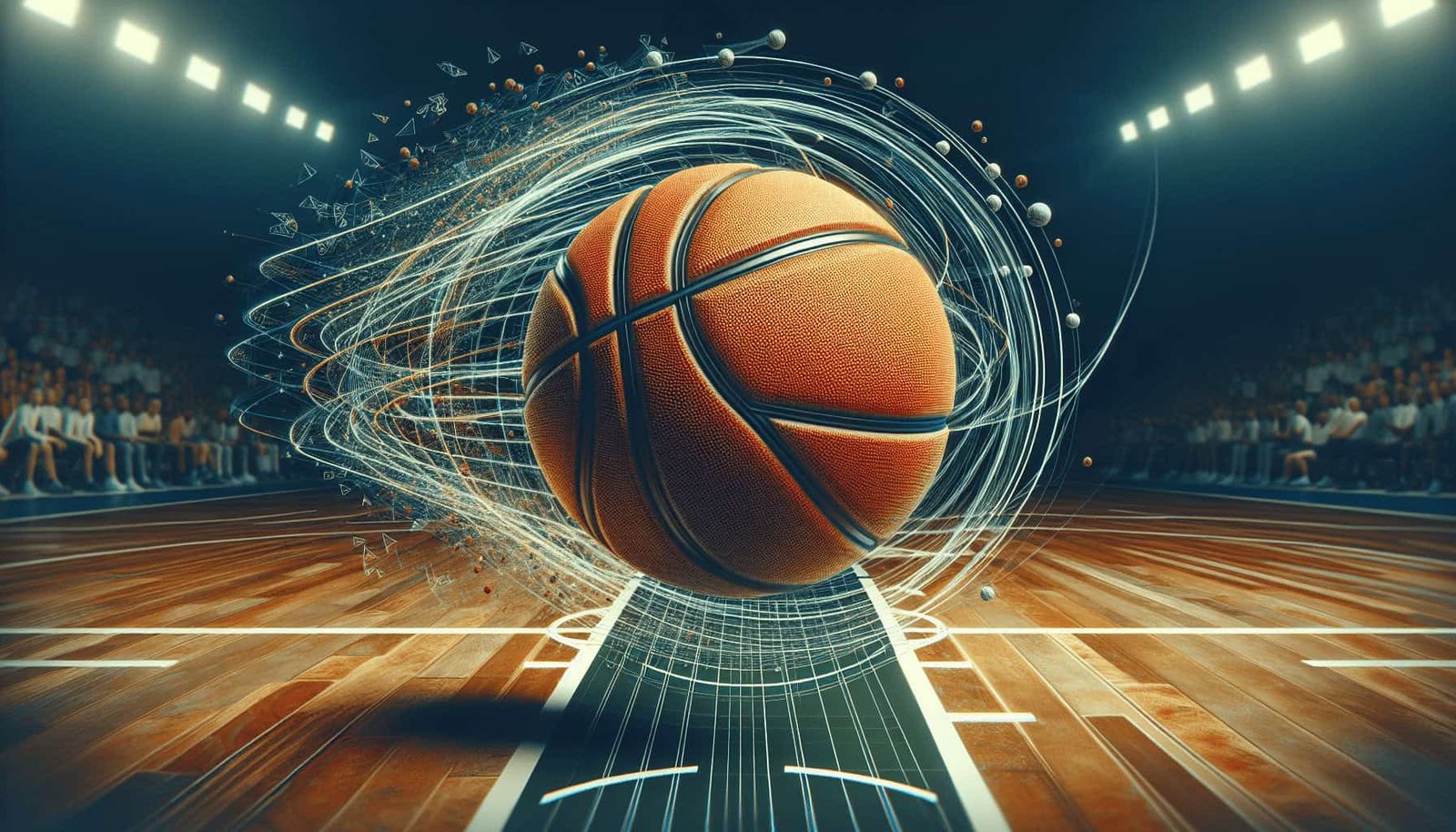Imagine standing on the basketball court, the ball in your hands, and the pressure mounting with each passing second. You know that the perfect shot could mean the difference between victory and defeat. But have you ever stopped to consider the role that basketball spin and rotation play in shooting? In this article, we will explore how the spin of the ball affects its trajectory and accuracy, and how mastering this fundamental aspect of the game can elevate your shooting skills to new heights. Get ready to unravel the secrets behind the perfect shot!

Understanding Basketball Spin
Definition of basketball spin
Basketball spin refers to the rotation of the ball as it is shot, pass, or dribbled. It is the result of the player imparting a twisting motion to the ball with their shooting hand. The spinning action creates a stabilizing effect on the ball’s flight, allowing for more accurate and controlled shots.
Importance of spin in basketball shooting
Spin plays a crucial role in basketball shooting as it directly affects the accuracy, range, and trajectory of the shot. A well-executed spin can enhance the shooter’s ability to consistently hit their target, increase the shooting range, and provide better control over the ball’s path in flight. Without proper spin, shots are more likely to be off-target, making it harder to score points.
Factors affecting spin in basketball shooting
Various factors can influence the spin on a basketball. These include the shooter’s shooting technique, grip and finger placement on the ball, release point, shooting form and body mechanics, and follow-through motion. Each of these elements contributes to the amount and type of spin applied to the ball, ultimately impacting the shot’s accuracy and effectiveness.
Effects of Basketball Spin on Shooting
Enhanced accuracy
Spin greatly enhances the accuracy of basketball shooting. When the ball rotates consistently, it stabilizes its flight, reducing the potential for unpredictable movements. The backspin or topspin on the ball helps to counteract air resistance and gravitational forces, allowing the ball to maintain a straighter trajectory towards the hoop. This increased accuracy translates to a higher shooting percentage and more successful shots.
Increased range
Proper spin also enables basketball players to extend their shooting range. The spin generates additional lift and stability, allowing the ball to travel farther with increased speed and control. This increased range opens up new scoring opportunities, making the shooter a greater threat on the court and expanding the offensive options for their team.
Improved trajectory control
Basketball spin provides the shooter with greater control over the ball’s trajectory. Backspin, for example, helps lift the ball, minimizing the impact of gravity and reducing the likelihood of a flat shot. On the other hand, topspin can be useful when shooting floaters or layups, as it creates a downward force on the ball, allowing it to arc over defenders or obstacles. By adjusting the amount and direction of spin, a player can adapt their shots to different situations, making it harder for defenders to contest and block their attempts.
Mechanics of Basketball Spin
Backspin vs Topspin
Backspin and topspin are the two primary types of spin used in basketball shooting. Backspin occurs when the shooter imparts a backwards rotation on the ball, causing it to spin away from them as it travels through the air. This type of spin creates an upward force, prevents the ball from bouncing off the rim sharply, and increases the chances of a friendly bounce into the basket. Topsin, on the other hand, involves spinning the ball in the direction of the shooter’s fingertips, causing it to rotate toward them as it moves through the air. Topspin is useful for shooting floaters or layups, allowing the ball to navigate over defenders and fall softly into the hoop.
Shooting technique and spin direction
The shooting technique employed by a player can significantly influence the direction of spin on the basketball. The way the ball is positioned in the hand, the release mechanics, and the follow-through motion all contribute to the spin direction. For a right-handed shooter, a proper technique tends to generate backspin, while a left-handed shooter will typically produce topspin. It is crucial for players to develop a consistent shooting technique that promotes the desired spin direction for their intended shots.
Grip and finger placement for optimal spin
The grip and finger placement on the basketball have a direct impact on the amount and quality of spin applied to the shot. A proper grip involves the shooter’s fingertips being spread evenly across the ball’s surface, with the thumb placed on the ball’s side. The fingers should exert enough pressure to have control over the ball while still allowing for a fluid and natural release of the shot. When the fingers roll off the ball during the release, it creates the desired rotation and spin necessary for accuracy and control.
The Role of Rotation in Shooting
Definition of rotation in basketball shooting
Rotation in basketball shooting refers to the axis of spin the ball experiences as it is released. It involves a twisting motion that causes the ball to rotate on its vertical axis, affecting its flight path. The rotation created during the shooting motion is what gives the ball stability, accuracy, and control as it travels towards the basket.
Importance of rotation in shooting technique
Rotation is crucial in shooting technique as it provides stability and consistency to the shot. By imparting rotation on the ball, shooters can counteract external forces such as air resistance, gravity, and unpredictable bounces. The rotation helps keep the ball on a more predictable and precise path, increasing the chances of a successful shot. Additionally, rotation adds a level of deception to the shot, making it more challenging for defenders to anticipate and block.
How rotation affects ball flight
The rotation applied to the ball affects its flight in multiple ways. First, rotation stabilizes the ball’s trajectory, allowing it to resist being affected by external forces. This stabilization helps counteract air resistance, keeping the ball on a straighter path towards the basket. Secondly, rotation affects the ball’s bounce off the rim. A well-rotated shot with backspin is more likely to hit the rim softly and bounce favorably, increasing the chances of the ball dropping into the basket. Lastly, rotation can influence the shooter’s ability to shoot over defenders or obstacles by altering the ball’s arc and angle of descent.

Factors Affecting Rotation in Shooting
Release point
The release point is a crucial factor in determining the amount and effectiveness of the rotation in the shot. Releasing the ball at the peak of the shooter’s jump ensures maximum power and control over the shot. It allows for a natural follow-through motion and optimal wrist snap, generating the desired rotation on the ball. A consistent and well-timed release point is essential for shooters to maintain control and accuracy in their shots.
Shooting form and body mechanics
The shooter’s overall shooting form and body mechanics directly affect the rotation applied to the basketball. Balance, posture, and alignment play a significant role in generating the necessary power and control for rotation. Proper footwork, shoulder alignment, and body position help facilitate a fluid and efficient shooting motion, ensuring the desired rotation is imparted to the ball. When the shooter’s form and mechanics are compromised, it can lead to insufficient or inconsistent rotation, negatively impacting the shot’s accuracy and effectiveness.
Follow-through motion
The follow-through motion is the continuation of the shooting motion after the ball is released. It plays a vital role in achieving optimal rotation. A smooth and consistent follow-through allows the shooter’s hand and wrist to maintain control over the ball’s spin throughout its flight. The ideal follow-through involves an upward extension of the arm, with the shooting hand finishing in a relaxed and balanced position, pointing towards the basket. Neglecting the follow-through motion can result in weak or improper rotation, affecting the shot’s accuracy and consistency.
Spin and Rotation’s Impact on Shooting Accuracy
How spin and rotation contribute to shot accuracy
Spin and rotation contribute significantly to the accuracy of a basketball shot. The stabilizing effect provided by rotation minimizes the potential for the ball to veer off course due to external factors. When the ball rotates consistently, it tends to maintain a straighter trajectory towards the basket, increasing the chances of a successful shot. The backspin or topspin on the ball also helps control the amount of force required to make the shot, allowing players to develop a better feel for their shooting range and accuracy.
Relationship between spin, rotation, and shooting percentage
The relationship between spin, rotation, and shooting percentage is strong and direct. Players who can consistently apply the right amount and type of spin to their shots tend to have higher shooting percentages. They are better equipped to control the ball’s flight, resulting in more accurate and successful shots. Additionally, the stabilizing effect of spin reduces the margin of error, increasing the likelihood of shots finding the bottom of the net. As such, mastering spin and rotation is a key factor in becoming an accurate and reliable shooter.
Examples of players utilizing spin and rotation for accuracy
Numerous basketball players have capitalized on the importance of spin and rotation to enhance their shooting accuracy. Legendary shooters like Ray Allen, Steph Curry, and Larry Bird have all exhibited exceptional control and consistency in applying spin and rotation to their shots. Their ability to maintain accuracy from various distances and angles can be attributed in part to their mastery of spin and rotation. These players serve as inspiration and role models for aspiring shooters looking to improve their effectiveness through better spin and rotation.

Shooting Drills to Develop Spin and Rotation
Form shooting with emphasis on spin
Form shooting drills are an effective way to develop and improve spin and rotation. By focusing on proper shooting technique and grip, players can develop a better understanding of how to generate the desired spin. Starting close to the basket and gradually moving out, players can work on applying consistent backspin or topspin to their shots. This drill helps develop muscle memory and promotes a fluid shooting motion that consistently imparts rotation on the ball.
One-handed shooting drills
Practicing shooting with one hand can be beneficial in developing spin and rotation. One-handed shooting drills force the player to rely on their shooting hand’s technique and control, emphasizing the importance of proper grip and follow-through. By removing the support of the non-shooting hand, players can focus more intently on generating the desired spin and rotation. These drills help refine the shooting motion and build muscle memory for consistent rotation.
Partner passing and shooting exercises
Partner passing and shooting exercises are valuable for incorporating game-like scenarios while developing spin and rotation. By practicing catch-and-shoot situations with a partner, players can work on generating rotation on the ball in real-time situations. These exercises simulate the pressure and timing involved in game situations, helping players develop the ability to apply the appropriate spin and rotation even under duress. Consistent repetition of these partner exercises builds confidence and accuracy in shooting.
Coaching Techniques for Teaching Spin and Rotation
Breaking down shooting mechanics
Coaches can effectively teach spin and rotation by breaking down shooting mechanics into fundamental steps. By focusing on each element separately, such as grip, release point, shooting form, and follow-through, coaches can help players better understand and master the mechanics behind spin and rotation. Breaking down the process allows for targeted instruction and feedback, enabling players to develop the necessary muscle memory and technique needed to consistently apply the desired spin.
Visual cues and demonstrations
Visual cues and demonstrations are powerful tools for teaching spin and rotation. Coaches can utilize video analysis or live demonstrations to showcase proper shooting technique and highlight the importance of spin and rotation. Visual cues, such as hand positions, release points, and follow-through motions, can provide players with a clear visual reference to replicate in their own shooting form. By combining verbal instruction with visual examples, coaches can enhance the learning experience and facilitate a better understanding of the role of spin and rotation.
Feedback and correction methods
Providing immediate feedback and correction is essential in helping players develop spin and rotation effectively. Coaches should offer constructive feedback on players’ shooting mechanics, addressing any issues with grip, release, or follow-through that may affect rotation. Promptly correcting these errors and offering guidance on how to adjust can help players hone their shooting technique and reinforce the importance of spin and rotation. Regular feedback and positive reinforcement also contribute to the players’ growth and confidence, encouraging them to continue improving their shooting skills.

Common Mistakes and Corrective Measures
Lack of spin on the ball
One common mistake is the failure to generate sufficient spin on the ball. This often results from improper hand position, inaccurate release point, or a weak follow-through motion. To address this, players should focus on establishing a proper grip, ensuring their fingertips have control over the ball’s surface. Emphasizing a consistent release point and incorporating a fluid follow-through motion will allow players to generate the necessary spin for accuracy and control.
Inconsistent rotation
Inconsistent rotation is another prevalent issue in shooting technique. It can stem from improper shooting mechanics, such as a rushed release or lack of wrist snap. Coaches should emphasize the importance of a smooth and controlled shooting motion, ensuring players take their time and maintain technique throughout the shot. Drills that isolate specific aspects of shooting, such as wrist flicks or slow-motion shooting, can help players develop a more consistent and reliable rotation.
Incorrect release point
An incorrect release point can negatively impact the ball’s rotation and flight. Releasing the ball too early or too late in the shooting motion can result in inconsistent or ineffective rotation. Coaches should stress the importance of releasing the ball at the peak of the jump, allowing for optimal power, control, and rotation. Regular practice and feedback can help players develop a better sense of timing and release point, leading to more accurate and consistent rotation.
The Future of Spin and Rotation in Shooting
Technological advancements for spin analysis
Advancements in technology continue to enhance the understanding and analysis of spin and rotation in basketball shooting. High-speed cameras, sensors, and motion-capture systems enable coaches and players to study and quantify spin in greater detail. These tools provide valuable data on the speed and angular velocity of the ball, allowing for a more comprehensive analysis of shooting technique and its impact on spin. As technology continues to progress, deeper insights into the role of spin and rotation in shooting will emerge, aiding in the development of more effective training methods.
Incorporating advanced analytics in shooting development
The increasing emphasis on data and analytics in basketball can extend to the study of spin and rotation. Advanced analytics can provide valuable insights into shooting performance, efficiency, and the impact of spin on shooting success. By incorporating spin-related metrics into player development programs, coaches and trainers can tailor their instruction and drills to target specific areas of improvement. Utilizing analytics will allow teams and players to optimize shooting techniques and gain a competitive edge in maximizing shooting accuracy.
Continued evolution of shooting techniques
The role of spin and rotation in shooting will continue to evolve as players push the boundaries of what is possible on the court. Creative shot-makers constantly experiment with new ways to manipulate spin and rotation to their advantage. As the game evolves, players will develop unique shooting techniques tailored to their strengths and styles while maximizing the benefits of spin and rotation. This ongoing evolution in shooting techniques will further enhance the importance of spin and rotation in basketball and inspire future generations of players to master these essential elements of shooting.
